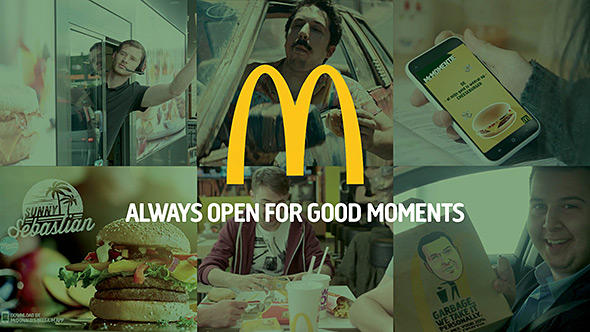1. MARKET SITUATION
It's 2014, the casual restaurant market is expanding, but not for McDonald's. New concepts are on the rise, meeting Belgians' expectations and shaking up the market. Products are better, more authentic, seasonal or sourced locally. More transparency and experience are key. Some of these concepts have even raised the burger to a trendy, sophisticated icon. Value for money is expected everywhere. And as Belgians get more used to e-commerce, they embrace home food delivery. Convenience has been redefined and is starting to become more important.
From 2012, McDonald's growth rate decreased, and our first reaction was to counter it by rearranging our media investments to adjust short-term sales by promoting our "cheaper" product line at the expense of our core products and Premium/Burger innovations.
In 2014, we applied the same strategy to our media and focused on our value products, aimed at increased frequency, but the business results still didn't improve.
At the beginning of 2015, we needed to face the fact that our retailer reflex driven by the international approach was inefficient and even less relevant to our Belgian customers. Time to create our own model, fundamentally reinventing our approach to meet consumer demands, while improving sales in the short term.
|
 |
2. OBJECTIVES
- Business objective: to reverse the trend and recover healthy annual growth in frequency and sales.
- Communication objectives: to become a strong and innovative brand again and thus overtake Quick which was nibbling at our position.
|
 |
3. STRATEGY
Consumer insight: 'The symbol of what people don't want anymore'
Our restaurants' plastic interior and the way we operated, based on fast ordering at the expense of customer experience, was at odds with customer demands. They want authenticity, better quality, good value for money and service, as well as fast service.
Strategy: Become leader again by creating more value for the customer and for the brand.
In 2015, we decide to abandon old fast food policies and to surprise by creating more value for the customer and for the brand, using 3 approaches and in 3 phases:
- 2015: Regain burger leadership by launching the Maestro range
From communicating defensively about product quality, we decide to integrate quality directly into our product innovation by adding new and unexpected ingredients to the burgers. All these innovations under the 'Maestro' umbrella create consistency and give substance to the perception of quality and innovation over time. Our Maestro range is higher priced, assuming that higher perceived quality justifies that price.
- 2016: Regain value leadership by repositioning the entry-level product range:
Move from pushing cheap prices to offering a great value snack.
All Eurodeals and Petits Plaisirs products were rebranded as McMoments and repositioned as great value snacks to get away from the Euro association, giving us greater pricing freedom (and profitability).
- 2017: Regain convenience leadership by putting the customer experience at the core: Move from being fast, to offering the best experience in and outside the restaurant.
- Digitalisation has enabled us to improve customers' experience while they wait; the order (digital kiosks and menu boards), and by launching table service while seated. Food is served faster, warmer and is therefore of higher quality. While the restaurants were closed to install the digital facilities, we used the opportunity to update their interiors in a warmer and more comfy style.
- Partnering with UberEats to launch the McDelivery service, bringing McDonald's experience straight into customers' homes.
|
 |
4. CREATIVE STRATEGY
The emotional and functional increase in value is translated into a phrase which still leads us today: "Always open for good moments". We provide good moments, not just good products. And we will never stop surprising people by what we do and how we do it.
- The Maestro range launch
Move from 'plastic' burgers to authentic burgers with their own personalities, names and qualifying adjectives. Showcasing the products' quality in slow motion, without having to defend it, because the quality is in the burger. Launching one new innovation each season and choosing its ingredients accordingly.
- Repositioning entry-level products
Move from pushing promotions to a culturally relevant snack. In order to talk about McMoments products, we need to reconnect with teens and youngsters by talking to them in their own language; Internet culture, memes, gifs and lots of puns. We managed to make McMoments part of Belgian Internet culture, with a strong visual identity and an ongoing presence, producing relevant, fresh and diverse content.
- Move towards customer experience
Make every moment spent at McDonald's fun and enjoyable.
- As table service was rolled out, customers were informed about the changes locally. Nevertheless, we decided to deliver a more emotional message to families, replacing the usual promotion-oriented formats. During the "Switch Off. Family On" campaign, we invited families to spend quality moments together. The restaurant tray mats were printed with games, finger twist, Bingo… We even surprised people by having Red Devils serve them at the Drive By.
- Instead of announcing our partnership with UberEats with an official press release, we let consumers experience our new McDelivery offer by allowing them to find our secret McDonald's restaurants which were hidden in peoples' homes.
|
 |
5. MEDIA STRATEGY
We needed to reconsider our calendar and media mix, to convey moments, not just products and prices. We shifted from a purely Paid Approach to a Paid and Owned Media Approach (ATL, social media, SEA, programmatic and loyalty app, digital menu boards, restaurants...). Move from a linear weekly retail model to a calendar combining peaks with continuous campaigns. Digital media has been given more weight by reducing TV investment.
- We used TV because of its vast reach, to reposition McDonald's as the innovative burger brand and showcase the Maestro line's quality. We took our first steps in influencer marketing with bloggers and Instagram users.
- Snacks can be eaten at any moment in the day, as can our McMoments. To communicate with youngsters throughout the year, we shifted from classic media to digital and social media, and launched our own Loyalty App.
- Choosing surprising activities (McDelivery, Red Devils...) to get people to experience the brand's values first hand.
|
 |
6. RESULTS
Putting the customer at the centre of our strategy has paid off with spectacular results. In just three years, we've exceeded our business objectives by doubling the annual visits growth rate and tripling annual sales growth. As far as brand image is concerned, McDonald's has managed to position itself once again as strong and innovative, and has reset the standards for the category.
|
 |
CLIENT
Mc Donald's
STIJN HEYTENS |
|
In 2015 Stijn returned to his 'previous professional love' McDonald's where he has the integrated responsibility for all 'customer facing' disciplines. Since a few years he took the leadership on accelerating the digital and experience transformation of McDonald's in Belgium. He is in charge of reshaping the way we bring forward delicious feel good moments to our guests. Stijn has the honour to be appointed as professor at the Worldwide Hamburger Marketing University of McDonald's Corporation.
Prior to re-joining McDonald's, he performed more than 5 years global marketing expertise at Unilin Flooring as global Marketing Director.
Before this, he was Marketing Manager at McDonald's. He gained first professional commercial experiences at Interbrew and Sara Lee Foods. Customer obsession and touchpoint marketing have always been his passion. Stijn graduated as a Master in Communication Sciences and obtained a Master in Marketing Management at the Vlerick Management School Leuven- Ghent.
|
 |
AGENCY
TBWA
AURÉLIE RUSSANOWSKI |
|
After obtaining a Master's degree in Business Management at ICHEC (Brussels) in 2006, Aurélie started on the advertiser's side. First she worked for the LVMH group (Dior) as a Media Manager for four years and afterwards as a Brand Manager for a Belgian fashion brand.
In 2014, her passion for consumer insights, societal trends and brand strategy made her move to the 'other side' and she started as Strategic Planner at TBWA\Belgium working for clients such as McDonald's and Alpro.
In 2017, she started sharing her expertise on the radio as an Advertising Trends expert for the radio station La Première. Bringing brands closer to the real world and people's real needs is was she does best.
|
 |










